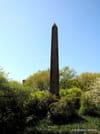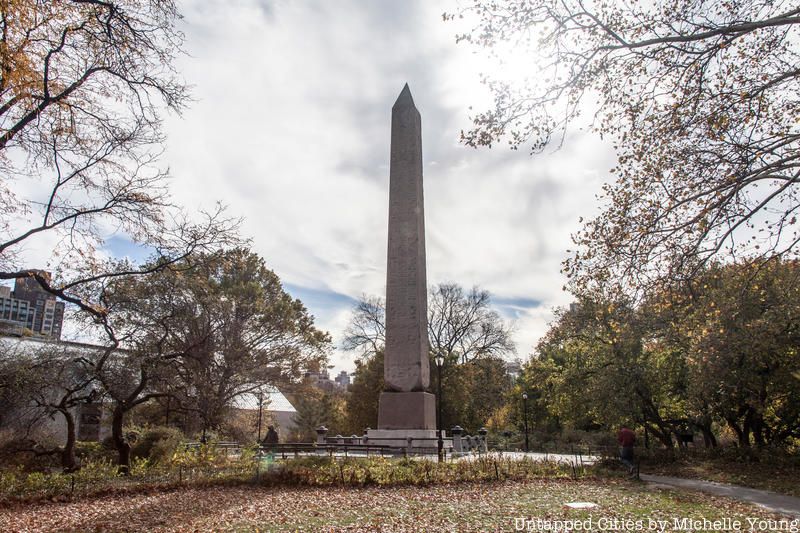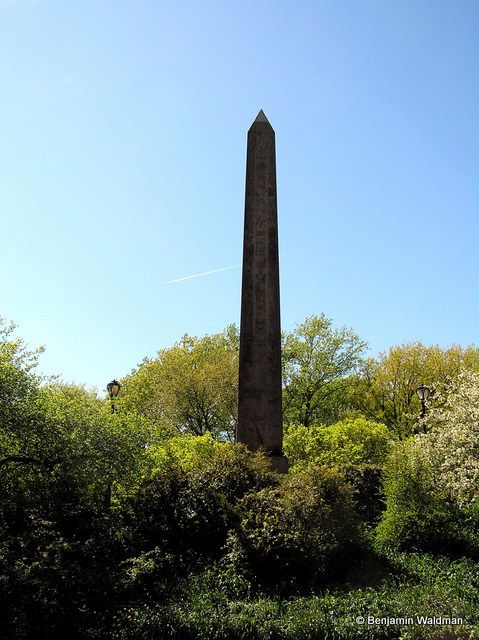Last Chance to Catch NYC's Holiday Notalgia Train
We met the voices of the NYC subway on our nostalgia ride this weekend!


 Cleopatra’s Needle in Place on Graywacke Knoll in by the Metropolitan Museum of Art
Cleopatra’s Needle in Place on Graywacke Knoll in by the Metropolitan Museum of Art
The anomaly of a wall of skyscrapers surrounding the verdant Victorian landscape of Central Park is matched by the surprising sight of Cleopatra’s Needle, an ancient Egyptian obelisk rising from a rock outcrop behind the Metropolitan Museum of Art. During a visit to New York City in July of 2011, the Egyptian Minister of Antiquities, Zahi Hawass visited the obelisk and noted some damage. He then threatened to “take the necessary steps to bring this precious artifact home and save it from ruin.” A grant allocation from the Partners in Preservation initiative would provide funds for a full-scale cleaning, detailed inspection of the surface and stabilization of crumbling portions of the granite shaft.
Why Cleopatra’s Needle is here and how it got here is an epic tale of engineering brilliance, Yankee ingenuity, clever diplomacy and sheer persistence.
Our story begins with the Egyptian Pharaoh Thutmose III who ordered two great granite obelisks to celebrate his jubilee in 1443 BC. They were ferried down the Nile from the quarries at Aswan and raised beside the portal of the Temple of the Sun in the city the Greeks called Heliopolis. 900 years later they were toppled and damaged by fire when the Persian army sacked and burned the city. That damage is visible today on the east face of the monument. About 10 BC Augustus Caesar ordered the two obelisks brought to Alexandria and raised in front of the Ceasarium, a new temple at the water’s edge dedicated to the newly-deified Julius Caesar. The temple eventually crumbled into the harbor and an earthquake in 1301 toppled one of the obelisks. There they remained, one vertical and one horizontal, surrounded by rubble and wooden shacks, until the spring of 1877 when the mellifluously named Henry Honeychurch Gorringe USN arrived in the harbor for repairs to his damaged ship.

During Gorringe’s stay in Alexandria, he and his crew visited the remaining obelisk (the other was carried off to London in 1875) and talked of how one might move it to America. In 1869 Ismail Pasha, khedive of Egypt, had mentioned the possibility of presenting the obelisk as a gift to the United States and when Gorringe returned to New York he was happy to talk to reporters about the Alexandria obelisk coming to America and how one might go about moving it to New York. After all, Paris had one and London and Constantinople had one and Rome had 13! In 1877 Henry Hurlbert owner of the New York World newspaper, started to raise interest in the project and convinced William Henry Vanderbilt to provide the money. Henry Stebbins, the city’s Commissioner of Parks was on board with his political support. Now Elbert Farman, American consul-general in Egypt began delicate diplomatic maneuvers to secure Cleopatra’s Needle for New York City.
The city’s newspapers ginned-up obelisk fever. A New York Herald reporter wrote, “It would be absurd for the people of any great city to hope to be happy without an Egyptian Obelisk! Why, London, Paris and Rome could point the finger of scorn at us and intimate that we could never rise to any real moral grandeur until we had our own obelisk!” In May of 1879 the khedive provided a letter making a gift of Cleopatra’s Needle to the city of New York.
Lt Commander Gorringe was given the daunting task of bringing the great granite monument from Alexandria to Central Park. The machinery needed to move and ship a stone shaft 69 ft high and 8 ft wide at the base was fabricated at John A Roebling’s & Sons, then in the midst of building the Brooklyn Bridge. In Alexandria, a British-built steamer, Dessoug, was purchased from the Egyptian government and fitted out to hold the 200 ton obelisk and its base, a 50 ton block of stone.
As excavation around the base and steps began in earnest, the site became a center of interest – the celebrated British explorer Sir Richard Burton dropped by along with the German adventurer Friedrich Rohlfs. Resistance to the American presence grew. Foreign and Egyptian residents of Alexandria were outraged at the prospect the obelisk’s removal to America. Legal impediments multiplied and angry crowds surrounded the waterfront worksite. Farman and Gorringe responded with plenty of WH Vanderbilt’s gold for bribes to lawyers and the protest leaders and Gorringe had a large American flag lashed to the top of the obelisk to symbolize clear title to the monument.
Adventures came as the ship crossed the Atlantic with squalls, waterspouts and storms but on July 19 she entered New York harbor and was anchored off Staten Island by the next day. A parade of 9000 Freemasons marched up Fifth Avenue for the solemn laying of the cornerstone on October 11, 1880. The obelisk took 16 weeks to move from 96th Street to Greywacke Knoll in Central Park, taking 19 days, night and day just to, cross the park on the 86th St transverse during bitter winter weather. Lt Commander Gorringe was there each and every step of the way, with his brilliant engineering talent and his dogged persistence, from Alexandria in Egypt to that rock knoll in Central Park.On January 22, 1881, before a huge crowd watching in utter silence, the obelisk was slowly and majestically lifted and turned into its upright position and then a great cheer went up. The formal presentation ceremony was held inside the Metropolitan Museum of Art on February 22, 1881. At last New York City had its own obelisk.
During the following summer of 1882 the mummy of Pharaoh Thutmose III was found in the Valley of the Kings and taken down the Nile by barge to the museum in Cairo. As Thutmose made his last journey down the river, the eminent Howard Carter recalled, “Men in the villages fired guns as for a funeral while the women followed along the bank, tearing their hair and making that shrill, wavering cry of mourning for the dead, a cry that has come right down from the days of the pharaohs themselves.”
William Henry Vanderbilt, who bankrolled the enterprise, died of apoplexy in the library of his great house on Fifth Avenue two years later. Lt Commander Henry Honeychurch Gorringe left the Navy in 1883, published a book detailing his adventures with obelisks and lectured widely. He died at 44 when he tried to board a moving train, tripped and was crushed when he fell between the train and the platform. He now rests in a cemetery in Nyack, New York, looking out on the Hudson River. A small obelisk marks his grave.
Cleopatra’s Needle can be found in Greywacke Knoll in Central Park just south of The Metropolitan Museum.
Follow Untapped Cities on Twitter and Facebook. Get in touch with the author at https://www.paulrushwalks.com/
Subscribe to our newsletter